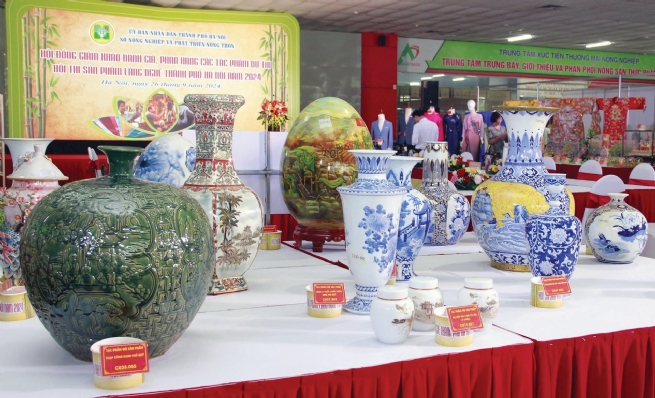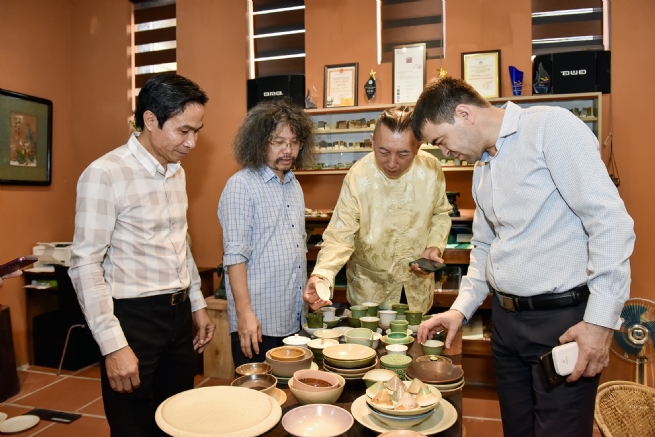11:21:30 AM | 6/16/2025
Hanoi boasts 1,350 craft villages, representing 40% of Vietnam’s total, positioning the city as a key hub for advancing the One Commune One Product (OCOP) Program.

Many products are showcased at the Hanoi Craft Village 2024 Competition
Effectively tapping into this strength not only supports rural economic development but also acts as a strategic solution to preserve and promote the cultural values of traditional cottage industries, bringing village products to broader domestic and international markets.
Among certified OCOP products, about 25% originate from craft and traditional craft villages. OCOP products have increasingly affirmed their place in the market thanks to a rigorous evaluation process that includes quality, packaging design and brand storytelling. As a result, once certified, OCOP products often grow market value, expand consumer base and increase incomes for producers.
Ngo Van Ngon, Deputy Director of the Hanoi Coordination Office of the New Rural Development Program, said: Hanoi, with 1,350 craft villages, not only guards the soul and essence of the culture but also acts as a vital force in driving rural economic development, especially through OCOP products in the context of global integration. Since 2019, Hanoi has assessed and rated 3,317 OCOP products, including six 5-star products, 22 potential 5-star products, 1,571 4-star products and 1,718 3-star products, leading the country in OCOP.
Bat Trang commune has more than 50 ceramic products certified as 3-5-star OCOP. While dominating much of the domestic market, Bat Trang ceramics are exported to many countries across Asia, Europe and the Americas. Signature products like dinnerware sets, tea containers, flower vases and fortune jars have been selected as gifts for conferences, public holidays and momentous local anniversaries. Not only known for their product quality, Bat Trang ceramic village also has attracted many tourists for its charming long-standing cultural values, artisans' creativity and visitors’ desire to experience pottery-making in a quintessential Northern Delta village setting. Pham Huy Khoi, Chairman of the Bat Trang People’s Committee, said that Bat Trang welcomes around 100,000 visitors annually, including many international tourists. The commune’s ceramic production and trade generate over VND2 trillion a year, with the average annual income of a person exceeding VND90 million. In 2024, Bat Trang aimed to have 10 more OCOP-certified products.

Bat Trang ceramic products
Xa Cau village in Quang Phu Cau commune (Ung Hoa district) is long known for its traditional incense-making trade. Born into a traditional incense-making family, Pham Thi Dong, Director of Viet Village Incense Essence Co., Ltd, boldly invested a handsome amount of money in modern production lines while preserving traditional incense types such as black incense, herbal incense, cinnamon incense and cardamom incense. “This year, I selected black incense, cardamom incense and cinnamon incense to participate in the OCOP evaluation and rating. These products not only retain the soul of the incense-making trade but are also favored by consumers for their mild, lasting and distinctive aroma,” she added.
Despite remarkable achievements, according to the Hanoi Coordination Office of the New Rural Development Program, OCOP products from craft villages still show certain limitations. They have grown rapidly in quantity rather than quality and uniqueness. The shortage of skilled professionals in branding and business management within craft villages leads to this reality. Most producers and smallholding businesses are keeping traditional methods, lacking market connections and lacking sufficient investment in packaging and product promotion.
Furthermore, the implementation of the OCOP Program in some districts is still challenging. Specifically, some businesses, cooperatives and households involved in agricultural production and trading are not very enthusiastic about joining the program. Support policies for OCOP development are not abundant and OCOP markets have not been significantly expanded.

Ung Hoa craft village
To harness the advantages of craft villages for OCOP development, according to many experts, a clearer and more consistent strategy is needed for the time ahead. First of all, the value of traditional crafts - valuable “cultural resources” for the OCOP Program - should continue to be reviewed, preserved and enhanced. At the same time, support should be strengthened for training human resources for OCOP producers, especially in branding management, packaging design, storytelling and digital application in commerce. Besides, it is necessary to pilot regional linkages and value chain linkages between craft villages, cooperatives and large businesses to establish competitive OCOP value chains.
The development of OCOP products should go beyond certification but build a complete OCOP ecosystem - from product design and display spaces to market connectivity. Local authorities should play an active role in fostering a supportive environment, assisting trade promotion, seeking export markets for OCOP products, and encouraging and guiding people to participate in the OCOP Program,” Ngon said.
By Do Ngoc, Vietnam Business Forum
|
This special section is supported by Hanoi Coordination Office of the New Rural Development Program |